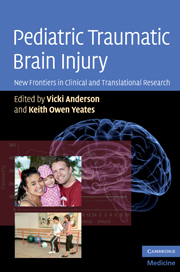Book contents
- Frontmatter
- Contents
- List of contributors
- Acknowledgments
- Introduction: Pediatric traumatic brain injury: New frontiers in clinical and translational research
- 1 Biomechanics of pediatric TBI
- 2 Neurobiology of TBI sustained during development
- 3 Using serum biomarkers to diagnose, assess, treat, and predict outcome after pediatric TBI
- 4 Clinical trials for pediatric TBI
- 5 Advanced neuroimaging techniques in children with traumatic brain injury
- 6 Neurobehavioral outcomes of pediatric mild traumatic brain injury
- 7 Very long-term neuropsychological and behavioral consequences of mild and complicated mild TBI: increased impact of pediatric versus adult TBI
- 8 Neurobehavioral outcomes of pediatric traumatic brain injury
- 9 Neuropsychological rehabilitation in children with traumatic brain injuries
- 10 Psychosocial interventions
- 11 Pediatric TBI: challenges for treatment and rehabilitation
- 12 Integrating multidisciplinary research for translation from the laboratory to the clinic
- Index
- Plate section
- References
6 - Neurobehavioral outcomes of pediatric mild traumatic brain injury
Published online by Cambridge University Press: 14 May 2010
- Frontmatter
- Contents
- List of contributors
- Acknowledgments
- Introduction: Pediatric traumatic brain injury: New frontiers in clinical and translational research
- 1 Biomechanics of pediatric TBI
- 2 Neurobiology of TBI sustained during development
- 3 Using serum biomarkers to diagnose, assess, treat, and predict outcome after pediatric TBI
- 4 Clinical trials for pediatric TBI
- 5 Advanced neuroimaging techniques in children with traumatic brain injury
- 6 Neurobehavioral outcomes of pediatric mild traumatic brain injury
- 7 Very long-term neuropsychological and behavioral consequences of mild and complicated mild TBI: increased impact of pediatric versus adult TBI
- 8 Neurobehavioral outcomes of pediatric traumatic brain injury
- 9 Neuropsychological rehabilitation in children with traumatic brain injuries
- 10 Psychosocial interventions
- 11 Pediatric TBI: challenges for treatment and rehabilitation
- 12 Integrating multidisciplinary research for translation from the laboratory to the clinic
- Index
- Plate section
- References
Summary
In the United States, approximately 475,000 children between the ages of 0 and 14 years are treated annually for traumatic brain injury (TBI) in hospital settings. Of these, 435,000 (91.5%) receive care and are released from the emergency department (Langlois et al.,2006). These data correspond to other estimates indicating that mild injuries account for 80% to 90% of all treated pediatric TBI (Cassidy et al., 2004). Rates of mild TBI are likely even higher than these numbers suggest, as many milder injuries go unreported entirely or are treated in outpatient settings and remain unaccounted for in hospital-based estimates (Sosin et al., 1996). Because severe TBI causes the vast majority of mortality and the most significant morbidity, it has attracted much of the scientific attention to date. However, given the sheer frequency of mild TBI and its potential for disruptive effects, these injuries clearly warrant scientific interest and investigation in their own right. The present chapter will focus on the neurobehavioral outcomes of mild TBI in childhood, highlighting relevant cross-disciplinary, translational research and collaborative opportunities.
Summary of neurobehavioral research findings
Ancient medical tracts, myths, legends, biblical texts, plays, and poems all indicate that mild TBI has been recognized since antiquity as a distinct type of head injury (Shaw, 2002). Nonetheless, for much of recorded history, the neurobehavioral outcomes of mild TBI were largely ignored scientifically, because mild TBI was assumed to produce transient functional impairment, not associated with underlying brain damage or lasting problems.
- Type
- Chapter
- Information
- Pediatric Traumatic Brain InjuryNew Frontiers in Clinical and Translational Research, pp. 94 - 117Publisher: Cambridge University PressPrint publication year: 2010
References
- 2
- Cited by

